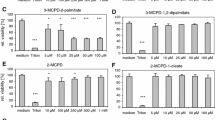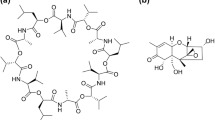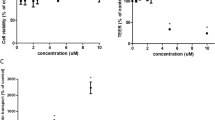Summary
Caco-2, a human intestinal cell lines able to differentiate in long-term culture, has been used to assess the cytotoxicity of the β-agonists clenbuterol, salbutamol and isoxsuprine, also used at high doses to obtain lean meat in food producing animals, and to investigate the eventual in vitro formation of early conjugates of these compounds. For this purpose, the cells have been characterized for the activity of UDP-glucuronyltransferase, which is present and increase in the differentiated cells, and for the β-receptors’ binding characteristics, which are those of β1 and β2 subtypes. Isoxsuprine was shown to be the most toxic, followed by clenbuterol and salbutanol. Conjugates have been observed after incubation of the cells both with the lowest isoxsuprine and the highest salbutamol concentrations. No conjugates were detected in the case of clenbuterol.
Similar content being viewed by others
References
Buttery P.J., Dawson J.W. (1987): The mode of action of beta-agonists as manipulators of carcass composition. In: Hanrahan J.P. (Ed) Beta-agonists and their effects on animal growth and carcass composition. London: Elsevier, 13–28.
Levy P., Robert A., Picard J. (1988): Biosynthesis of glycosaminoglycans in the human colonic tumor cell line Caco-2: structural changes occuring with the morphological differentiation of the cells. Biol. Cell, 62, 255–264.
Levy P., Cherqui G., Robert A., Wicek D., Picard J. (1989): Changes in glycosaminoglycan sulfation and protein kinase C subcellular distribution during differentiation of the human colon tumor cell line Caco-2 Experientia, 45, 588–591.
Matsumoto H., Erickson R.H., Gum J.R., Yoshioka M., Gum E., Kim Y.S. (1990): Biosynthesis of alkaline phosphatase during differentiation of the human colon cancer cell line Caco-2. Gastroenterology, 98, 1199–1207.
Boulenc X., Bourrie M., Fabre I., Roque C., Joyeux H., Berger Y., Fabré G. (1992): Regulation of cytochrome P 450 IA1 gene expression in a human intestinal cell line Caco-2. J. Pharm. Exp. Ther., 263, 1471–1477.
Peters H.N., Roelofs M.J. (1989): Time-dependent activity and expression of glutathione S-tranferases in the human colon adenocarcinoma cell line Caco-2. Biochem. J., 264, 613–616.
Smith P. (1986): Gastrointestinal physiology. In: Rozman O.H. (Ed) Gastrointestinal toxicology. Amsterdam: Elsevier, 1–28.
Pompa G., Caloni F., Montana M., Pasqualucci C. (1994): Prolonged presence of isoxsuprine in equine serum after oral administration. Xenobiotica, 24, 339–346.
Re G., Badino P., Novelli A., Girardi C. (1995): Identification of b-adrenoceptor subtypes in bovine ovarian and myometrial cell membranes. Br. Vet. J., 151, 567–578.
Lowry O.H., Rosebrough N.J., Farr A, Randall R.J. (1951): Protein measurements with the Folin reagent. J. Biol. Chem., 193, 265–275.
Morin D., Zini R., Urien S., Sapena R., Tillement J. (1992): Labelling of rat brain β-adrenoceptors: [3H]-CGP-12177 or [125I]-iodocyanopindolol? J. Receptor Res., 12, 369–387.
Law M.P. (1993): Demonstration of the suitability of CGP-12177 for in vivo studies of β-adrenoceptors. Br. J. Pharmacol., 109, 1101–1109.
Vivat V., Cohen-Tannoudji J., Revelli J.P. et al. (1992): Progestrone transcriptionally regulates the β2-adrenergic receptor gene in pregnant rat myometrium. J. Biol. Chem., 267, 7975–7978.
Lemoine H. (1992): β-Adrenoceptor ligands: characterization and quantification of drug effects. Quant. Struct Act. Relat., 11, 211–218.
Scatchard G. (1949): The attraction of proteins for small molecules and ions. Ann. NY Acad. Sci., 51, 660–669.
Tallarida R.J., Murray R.B. (1987): Manual of pharmacologic calculations with computer programs, 2nd edn. New York: Springer, 110–128.
Liliemblum K. (1982): Differential induction of rat liver microsomal UDP-glucuronyltransferase activities by various inducing agents. Biochem. Pharmacol., 31, 907–913.
Koster A., Meewisse C., Noordhoek J. (1984): Glucuronidation in rat intestinal cells. Dependence of glucose supply and resistance to inhibition by ethanol and fasting. Arch. Toxicol., 55, 123–126.
Bjorge S., Hamelehle K.L., Homan R., Rose S.E., Turluck D., Scott Wright D. (1991): Evidence for glucuronide conjugation of p-nitrophenol in the Caco-2 cell model. Pharm. Res., 8, 1441–1443.
Sergent-Engelen T., Delistrie V., Schneider Y-J. (1993): Phase I and II biotransformations in living Caco-2 cells cultivated under serum-free conditions. Biochem. Pharmacol., 46, 1393–1401.
Peters W., Roelofs H. (1992): Biochemical characterization of resistance to mitoxantrone and adriamycin in Caco-2 human colon adnocarcinoma cells: a possible role of glutathione-S-transferase. Cancer Res., 52, 1886–1890.
Abid A., Bouchon I., Siest G., Sabolovic N. (1995): Glucuronidation in the Caco-2 human intestinal cell line: induction of UDP-glucuronosyltransferase 1*6. Biochem. Pharmacol., 50, 557–561.
Morgan D., Paul J.D., Richmond B.H., Wilson-Evered E., Ziccone S.P. (1986): Pharmacokinetics of intravenous and oral salbutamol and its sulphate conjugate. Br. J. Clin. Pharmacol., 22, 587–593.
Matthews N.S., Gleed R.D., Short C.E., Burrows K. (1986): Cardiovascular and pharmacokinetic effects of isoxsuprine in the horse. Am. J. Vet. Res., 47, 2130–2133.
Witkamp R. (1996): Pharmacological and toxicological properties of β-agonists. In: Enne G., Kuiper H.A., Valentini A. (Eds) Residues of veterinary drugs and mycotoxins in animal products. New methods for risk assessment and quality control. Proceedings of the first electronic mail conference, Wageningen Pers, 113–123.
Martin L., Hobson J., Page J., Harrison C. (1971): Metabolic studies of salbutamol-3H: a new bronchodilator in rat, rabbit, dog and man. Eur. J. Pharmacol., 14, 183–199.
Pidgeon C., Ong S., Liu H. et al. (1995): IAM chromatography: an in vitro screen for predicings drug membrane pemeability. J. Med. Chem., 38, 590–594.
Author information
Authors and Affiliations
Rights and permissions
About this article
Cite this article
Stammati, A., Badino, P., De Angelis, I. et al. In vitro toxicity and formation of early conjugates in Caco-2 cell line treated with clenbuterol, salbutamol and isoxsuprine. European Journal of Drug Metabolism and Pharmacokinetics 22, 173–178 (1997). https://doi.org/10.1007/BF03189802
Received:
Issue Date:
DOI: https://doi.org/10.1007/BF03189802




